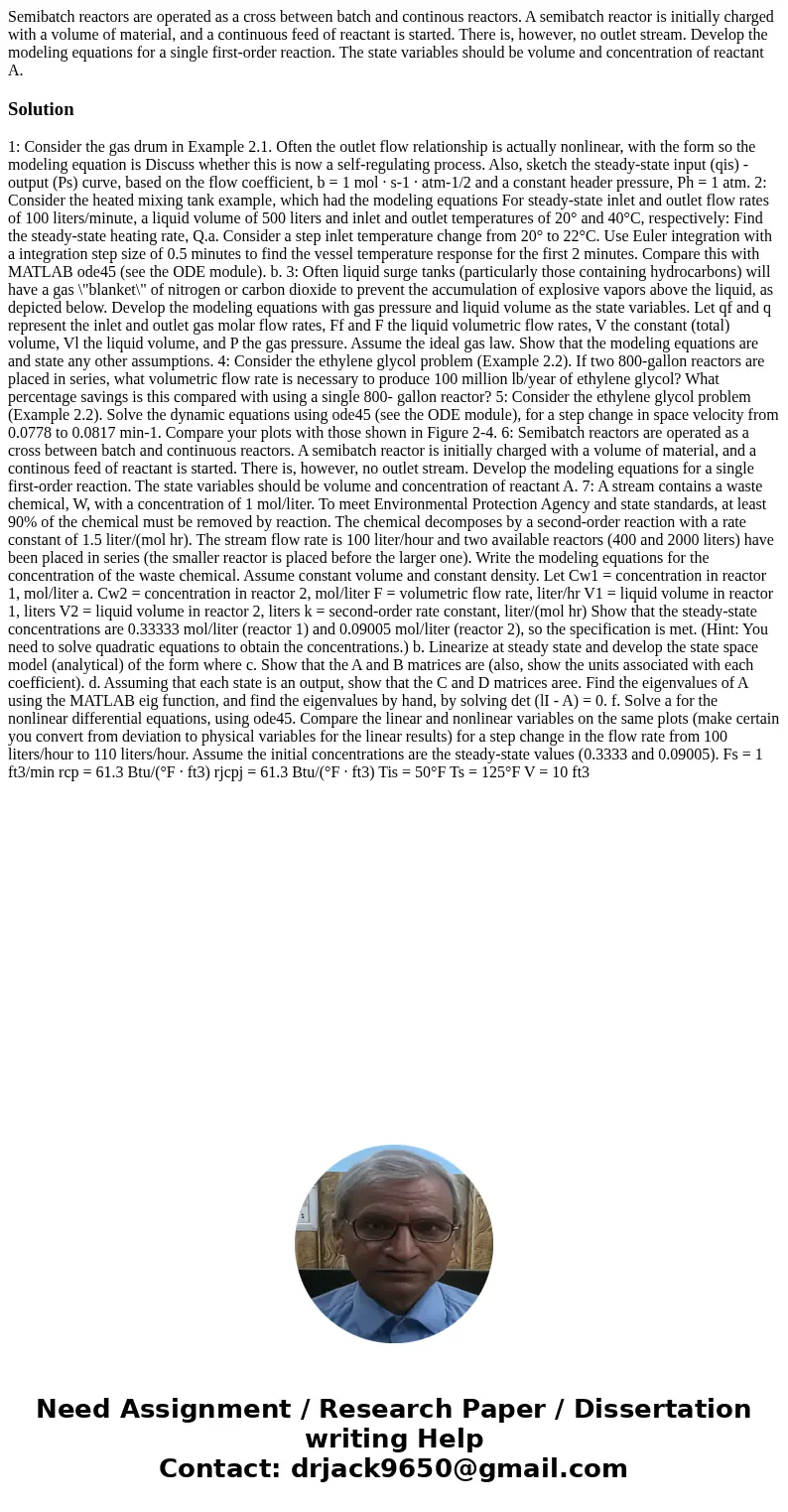Semibatch reactors are operated as a cross between batch and
Semibatch reactors are operated as a cross between batch and continous reactors. A semibatch reactor is initially charged with a volume of material, and a continuous feed of reactant is started. There is, however, no outlet stream. Develop the modeling equations for a single first-order reaction. The state variables should be volume and concentration of reactant A.
Solution
1: Consider the gas drum in Example 2.1. Often the outlet flow relationship is actually nonlinear, with the form so the modeling equation is Discuss whether this is now a self-regulating process. Also, sketch the steady-state input (qis) -output (Ps) curve, based on the flow coefficient, b = 1 mol · s-1 · atm-1/2 and a constant header pressure, Ph = 1 atm. 2: Consider the heated mixing tank example, which had the modeling equations For steady-state inlet and outlet flow rates of 100 liters/minute, a liquid volume of 500 liters and inlet and outlet temperatures of 20° and 40°C, respectively: Find the steady-state heating rate, Q.a. Consider a step inlet temperature change from 20° to 22°C. Use Euler integration with a integration step size of 0.5 minutes to find the vessel temperature response for the first 2 minutes. Compare this with MATLAB ode45 (see the ODE module). b. 3: Often liquid surge tanks (particularly those containing hydrocarbons) will have a gas \"blanket\" of nitrogen or carbon dioxide to prevent the accumulation of explosive vapors above the liquid, as depicted below. Develop the modeling equations with gas pressure and liquid volume as the state variables. Let qf and q represent the inlet and outlet gas molar flow rates, Ff and F the liquid volumetric flow rates, V the constant (total) volume, Vl the liquid volume, and P the gas pressure. Assume the ideal gas law. Show that the modeling equations are and state any other assumptions. 4: Consider the ethylene glycol problem (Example 2.2). If two 800-gallon reactors are placed in series, what volumetric flow rate is necessary to produce 100 million lb/year of ethylene glycol? What percentage savings is this compared with using a single 800- gallon reactor? 5: Consider the ethylene glycol problem (Example 2.2). Solve the dynamic equations using ode45 (see the ODE module), for a step change in space velocity from 0.0778 to 0.0817 min-1. Compare your plots with those shown in Figure 2-4. 6: Semibatch reactors are operated as a cross between batch and continuous reactors. A semibatch reactor is initially charged with a volume of material, and a continous feed of reactant is started. There is, however, no outlet stream. Develop the modeling equations for a single first-order reaction. The state variables should be volume and concentration of reactant A. 7: A stream contains a waste chemical, W, with a concentration of 1 mol/liter. To meet Environmental Protection Agency and state standards, at least 90% of the chemical must be removed by reaction. The chemical decomposes by a second-order reaction with a rate constant of 1.5 liter/(mol hr). The stream flow rate is 100 liter/hour and two available reactors (400 and 2000 liters) have been placed in series (the smaller reactor is placed before the larger one). Write the modeling equations for the concentration of the waste chemical. Assume constant volume and constant density. Let Cw1 = concentration in reactor 1, mol/liter a. Cw2 = concentration in reactor 2, mol/liter F = volumetric flow rate, liter/hr V1 = liquid volume in reactor 1, liters V2 = liquid volume in reactor 2, liters k = second-order rate constant, liter/(mol hr) Show that the steady-state concentrations are 0.33333 mol/liter (reactor 1) and 0.09005 mol/liter (reactor 2), so the specification is met. (Hint: You need to solve quadratic equations to obtain the concentrations.) b. Linearize at steady state and develop the state space model (analytical) of the form where c. Show that the A and B matrices are (also, show the units associated with each coefficient). d. Assuming that each state is an output, show that the C and D matrices aree. Find the eigenvalues of A using the MATLAB eig function, and find the eigenvalues by hand, by solving det (lI - A) = 0. f. Solve a for the nonlinear differential equations, using ode45. Compare the linear and nonlinear variables on the same plots (make certain you convert from deviation to physical variables for the linear results) for a step change in the flow rate from 100 liters/hour to 110 liters/hour. Assume the initial concentrations are the steady-state values (0.3333 and 0.09005). Fs = 1 ft3/min rcp = 61.3 Btu/(°F · ft3) rjcpj = 61.3 Btu/(°F · ft3) Tis = 50°F Ts = 125°F V = 10 ft3
 Homework Sourse
Homework Sourse